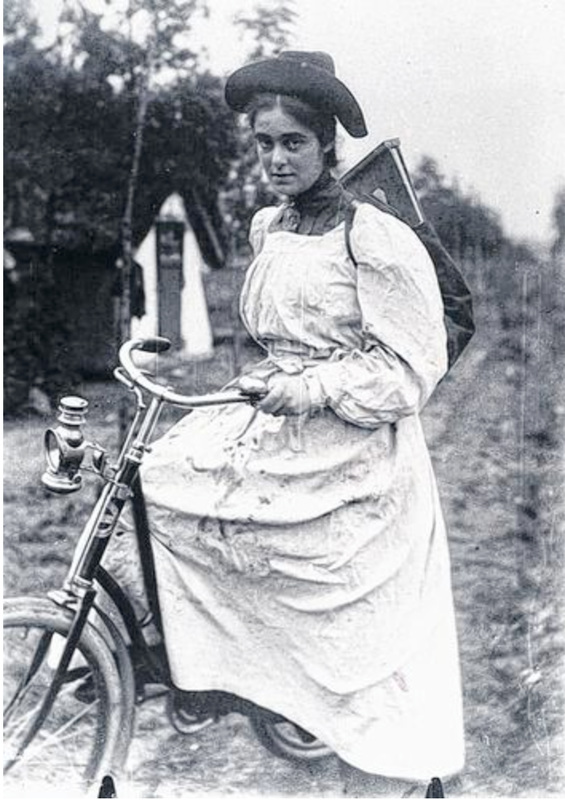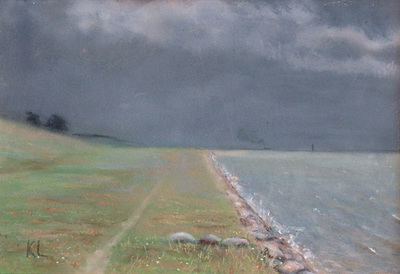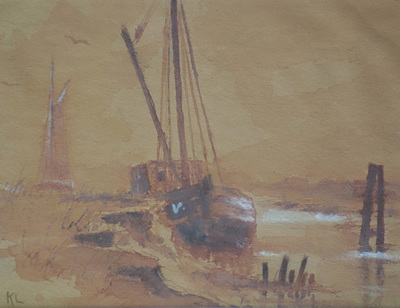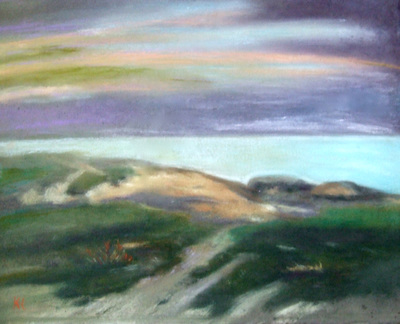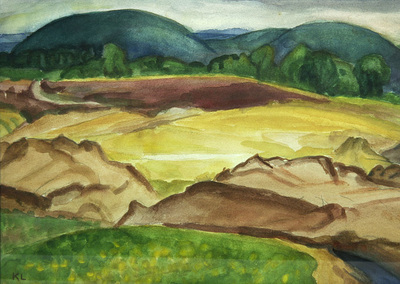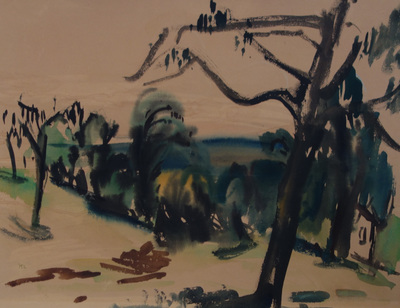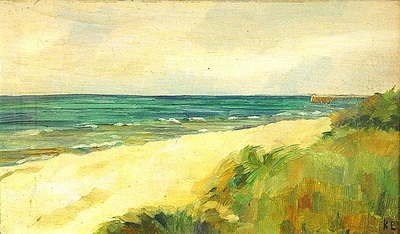KÄTHE LOEWENTHAL 1878 -1942Käthe Frida Rosa Loewenthal (27.03.1878–26.04.1942; deported and murdered in Izbica, Poland) was the oldest daughter of the Loewenthal family in Berlin. She and her four sisters often accompanied their father Wilhelm, an internationally renowned ophthalmologist and hygienist, when he worked abroad; this gave her the chance to experience life in countries such as France, Switzerland and Argentina. Käthe took her first lessons in painting at the age of 12, and when she was around 16 she became acquainted with the Symbolist art of Ferdinand Hodler during a trip to Switzerland. A year later, she embarked on a course of study with him and began to pursue landscape painting. To broaden her artistic training, Käthe Loewenthal took classes with Leo von König at his painting studio in Berlin around 1900, and in 1905 she attended the Ladies’ Academy of the Münchner Künstlerinnenverein (Munich Association of Women Artists). When the Art Academy in Stuttgart finally opened its doors to women, Käthe was one of the first to be matriculated, and from 1910 to 1914 she was taught there by Adolf Hölzel, a leading exponent of abstract art. She became a member of the Württembergischer Malerinnenverein, a local female artists’ association, and had a studio apartment in the association building until 1911. She was then appointed a city-owned studio space in Stuttgart, where she continued to work until 1934. Over the years she produced numerous landscapes during painting trips to Switzerland, Italy and the island of Hiddensee in the Baltic Sea. Käthe Loewenthal’s planar style of painting and reduced forms show the influence of Japonisme, which was a very popular trend in European art at that time. While many of her fellow painters welcomed the First World War as a liberating force that would bring an end to Wilhelminism, Käthe Loewenthal was less optimistic. She became an anthroposophist, campaigned for equal rights and went on to build a successful artistic career, taking part in major exhibitions at the Stuttgart Secession, the Verband der Kunstfreunde in den Ländern am Rhein, the Frauen-Kunstverband and the Württembergischer Malerinnenverein, among others. Her work was also included in the “Große schwäbische Kunstschau” (Grand Swabian Art Exhibition) organised by the Künstlerbund, one of the many regional and national artists’ associations she joined. From 1902 onwards Käthe was in a relationship with the painter Erna Raabe Freiin von Holzhausen, and they moved in together in 1909. When Erna became seriously ill in the 1930s, Käthe cared for her until her death in 1938. From 1934, Käthe faced censorship as an artist of Jewish descent, and was banned from painting by the Nazis. She was eventually forced to move into a Judenhaus (‘Jews’ house’) in Stuttgart-Kaltental. During this time, she hid her paintings but kept in contact with other ostracised artists. In 1942 she was interned in a camp in Weißenstein, Baden-Württemberg. From here she was deported to the Izbica concentration camp in Poland, and was declared dead in the same year. Käthe Loewenthal’s sisters were also subjected to Nazi persecution. Agnes Schaefer, née Loewenthal (08.04.1882–13.10.1933; vanished without trace in the Greek mountains), was a photographer who worked for Erna Lendvai-Dircksen and Eduard von Wasow, and was later employed by Nikos Zographos in his Athens studio. In 1933 she fled into the nearby mountains and presumably took her own life there, as no further trace of her was ever found. Susanne Ritscher, née Loewenthal (30.01.1886–1975), followed in her older sister’s footsteps and became a freelance painter based in Hiddensee and Berlin. In 1944 she went into hiding in the Swabian Jura mountains and subsequently fled to Munich. In February 1945 she was arrested and interned in the collection camp at Berg am Laim. Having survived the Holocaust, she resumed painting in 1950 and died in 1975. Susanne was the only one of the five sisters to die a natural death. Carola Muysers Sources: http://berlin-woman.de/index.php/2016/04/04/berlin-women-kaethe-loewenthal/#more-39736 Berlin-Women: Käthe Loewenthal, Landschaftsmalerin (27.03.1878-1942 deportiert und getötet) Scroll down for German version |
KÄTHE LOEWENTHAL 1878 -1942Käthe Frida Rosa Loewenthal (27. März 1878-1942 Deportation nach Izbica/Polen; für tot erklärt) ist die älteste Tochter der Familie. Ihr Vater Wilhelm Loewenthal, ein international bekannter Berliner Augenarzt und Hygieniker, nimmt sie und ihre vier Schwestern oft auf Dienstreisen mit. Sie lernt Frankreich, die Schweiz und Argentinien kennen. Mit 12 Jahren besucht Käthe Loewenthal ihre ersten Malkurse, mit ca. 16 Jahren sieht sie bei einem Schweizaufenthalt die symbolistische Kunst Ferdinand Hodlers. Ein Jahr später nimmt sie ein Studium bei ihm auf und entdeckt für sich die Landschaftsmalerei. Sie strebt eine umfassende Ausbildung und Weiterbildung an, besucht um 1900 das Malatelier von Leo von König in Berlin und 1905 die Damenakademie des Münchner Künstlerinnenvereins. Als die Kunstakademie Stuttgart ihre Türen für Frauen öffnet, ist Käthe Loewenthal unter den ersten offiziellen Studentinnen. Sie studiert 1910-1914 beim Haupvertreter der abstrakten Kunst, Adolf Hölzel. Bis 1911 hat sie eine Atelierwohnung im Haus des Württembergischen Malererinnenvereins, wo sie auch Mitglied ist. Dann bezieht sie bis 1934 ein städtisches Atelier in Stuttgart. Studienreisen führen sie in die Schweiz, nach Italien und nach Hiddensee, es entstehen zahlreiche Landschaften. Mit ihrer Flächenmalerei und den reduzierten Formen greift sie den damals neuen und vielfach rezipierten Japonismus auf. Während ihre Kollegen den Ersten Weltkrieg als Befreiung vom Wilhelminismus begrüßen, bleibt sie verhalten. Sie schließt sich den Anthroposophen an und engagiert sich für die Gleichberechtigung. Käthe Loewenthal macht Karriere, sie ist auf großen Ausstellungen zu sehen, z.B. in der Stuttgarter Secession, im Verband der Kunstfreunde in den Ländern am Rhein, im Frauen-Kunstverband, der Großen schwäbischen Kunstschau des Künstlerbunds und im Württembergischen Malerinnenverein. In den genannten Vereinen ist sie auch Mitglied. Seit 1902 hat sie eine Partnerschaft mit der Malerin Erna Raabe Freiin von Holzhausen, mit der sie ab 1909 zusammenlebt. 1934 kommt die Zensur, die Nazis erteilen der jüdisch stämmigen Künstlerin Malverbot. Sie wird in eine sogenannte „Judenwohnung“ in Stuttgart-Kaltental eingewiesen. Käthe Loewenthal pflegt ihre schwerkranke Partnerin, versteckt ihre Bilder und hält Kontakt zu anderen verfehmten Kollegen. Dann wird sie in ein Lager im Württembergischen Weißenstein inhaftiert, 1942 in Richtung des Konzentrationslagers Izbica abtransportiert und im selben Jahr für tot erklärt. Auch ihre Schwestern sind Opfer der Naziverfolgung. Die Fotografin Agnes Schaefer, geb. Loewenthal (08.04.1882-13.10.1933 vermisst in den Bergen Griechenlands) arbeitet für Lendvai-Dircksen und Eduard von Wasow und das Athener Fotostudio von Nikos Zographos. 1933 flieht sie vor den Nazis in die griechischen Berge, wo sich ihre Spur verliert. Susanne Ritscher, geb. Loewenthal (30.01.1886-1975) tritt in die Fußstapfen der älteren Schwester und wird ebenfalls freischaffende Malerin in Hiddensee und Berlin. 1944 taucht sie in der Schwäbischen Alp unter, flüchtet nach München und wird im Februar 1945 ins Lager Berg am Laim interniert. Sie überlebt, nimmt 1950 ihre Malerei wieder auf und stirbt als einzige der fünf Schwestern eines natürlichen Todes. Carola Muysers Quellen: http://berlin-woman.de/index.php/2016/04/04/berlin-women-kaethe-loewenthal/#more-39736 Berlin-Women: Käthe Loewenthal, Landschaftsmalerin (27.03.1878-1942 deportiert und getötet) Hochscrollen zur englischen Version |
